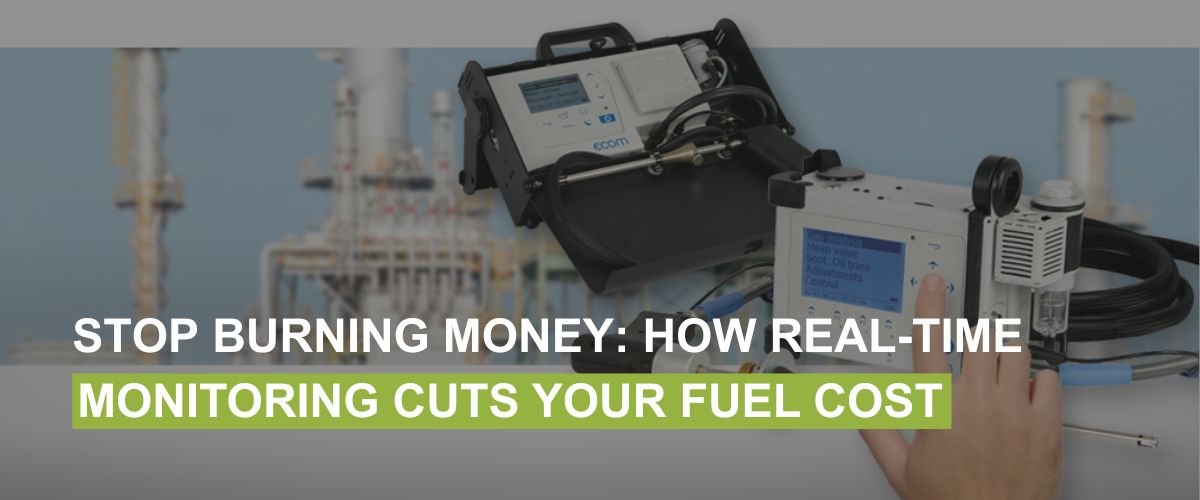What if your boiler told you, in plain numbers, where your money was burning away? Most plants feel fuel costs rising long before anyone sees the root cause. We’ve spent over two decades around steam lines, stacks, and burner rooms. The same pattern shows up again and again. A few percentage points off in combustion today quietly turns into big losses over a quarter.
Why “Good Enough” Combustion isn’t Enough
Combustion is dynamic. Gas quality shifts. Ambient temperature changes. Dampers drift. A setup done in the morning can slip by afternoon. If you tune once a quarter, you’re guessing for the 89 days in between. Real-time flue gas analysis replaces guesswork with data at the stack. You see oxygen, CO, CO2, and sometimes NOx as conditions change. That lets you trim excess air, catch incomplete combustion, and lock-in efficiency with confidence.
A Simple Rule that Saves Money
Every percent drop in excess O2 can deliver meaningful fuel savings, provided CO stays low. Most plants run safer with a cushion. That cushion often grows over time. Real-time analyzers help you set the right cushion and hold it there. You reduce stack losses without flirting with unsafe CO.
A Day in a Textile Plant
Picture a 6-ton boiler feeding process steam to dyeing machines. Morning load ramps up, so the burner swings. By afternoon, ambient heat pushes the draft slightly out of tune. Without live data, operators leave extra air to be safe. Fuel use creeps up 3% to 5%. With a flue gas analyzer tied into the control room, the team sees O2 rising above target. They nudge the damper and restore the sweet spot. CO stays clean. Steam stays steady. Over a month, that small adjustment pays for itself.
Sugar Mill Season and the Moving Target
In crushing season, bagasse quality varies hour to hour. Moisture content shifts. Operators chase stability. A fixed setting cannot keep up. Real-time flue gas analysis turns variability into actionable numbers. Your team reacts early, not after a boiler trip or a fuel spike. You keep combustion efficient while protecting tubes and maintaining output.
What to Watch and How to Act
- O2: Too high wastes heat up the stack. Too low risks CO. Track and target a tight band.
- CO: Your safety and efficiency alarm. If CO rises, address mixing, air, or burner health.
- Flue gas temperature: A rise can signal fouling or too much excess air. A steady baseline indicates healthy heat transfer.
- Trends: Don’t chase single points. Watch patterns across shifts and loads. Use the data to plan maintenance.
With portable analyzers, you can audit lines and verify tuning. With continuous analyzers, you can hold targets all day. Either way, you give operators a live compass.
Actionable Insights for Fuel Efficiency
- Set clear O2 and CO targets for each load range.
- Train operators to respond to trends, not hunches.
- Schedule quick weekly checks to prevent drift.
- Tie analyzer alerts to burner control routines, if your system supports it.
- Log results. Share wins. Savings build culture.
Where Encom Usually Steps In
In many plants, we start with a baseline survey. We bring certified flue gas analyzers, map the load curve, and identify the best O2-CO window for that specific boiler, burner, and fuel. Then we help the team hold that window with practical SOPs. Sometimes that includes integrating analyzers with controls, sometimes it’s operator coaching and a quarterly health check. The point is simple. Keep combustion in tune every day, not only on service days.
The Bottom Line
Fuel is your biggest ongoing cost. Real-time flue gas monitoring helps you protect it with facts, not assumptions. If you want a straightforward path to lower fuel use, steadier steam, and cleaner stacks, talk to Encom Pakistan. For over 20 years, we’ve supported boilers, burners, and HVAC systems across the country with OEM-certified expertise and dependable after-sales service. If you need a partner who understands Pakistani industry and delivers results, Encom is ready to help.

